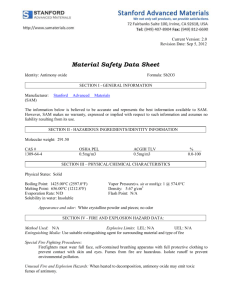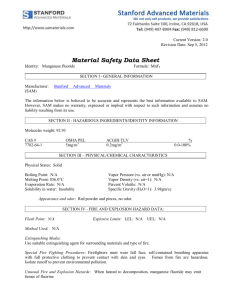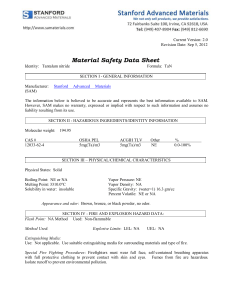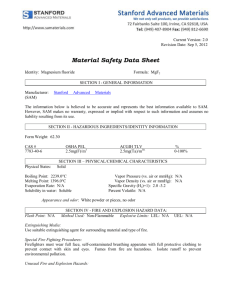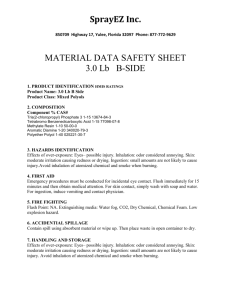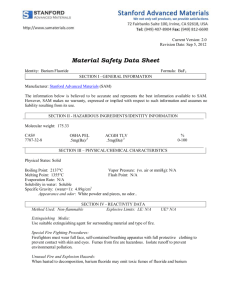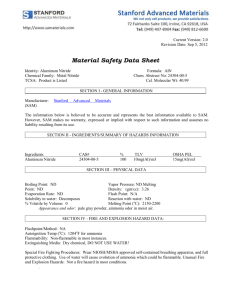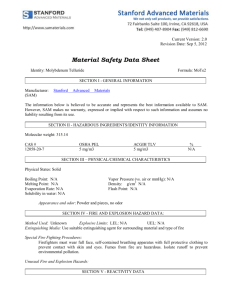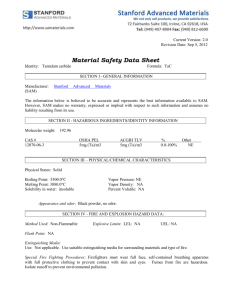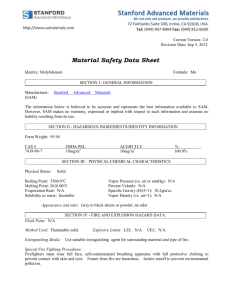Microsoft Word - Ni - Stanford Advanced Materials
advertisement
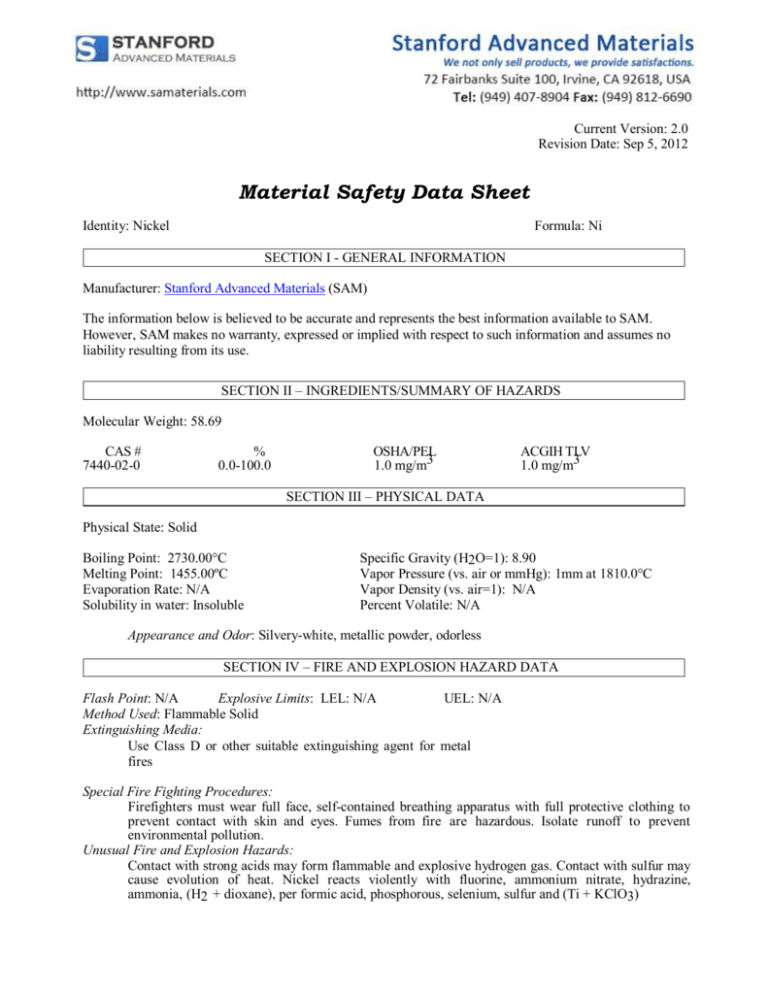
Current Version: 2.0 Revision Date: Sep 5, 2012 Material Safety Data Sheet Identity: Nickel Formula: Ni SECTION I - GENERAL INFORMATION Manufacturer: Stanford Advanced Materials (SAM) The information below is believed to be accurate and represents the best information available to SAM. However, SAM makes no warranty, expressed or implied with respect to such information and assumes no liability resulting from its use. SECTION II – INGREDIENTS/SUMMARY OF HAZARDS Molecular Weight: 58.69 CAS # 7440-02-0 % 0.0-100.0 OSHA/PEL 1.0 mg/m3 ACGIH TLV 1.0 mg/m3 SECTION III – PHYSICAL DATA Physical State: Solid Boiling Point: 2730.00°C Melting Point: 1455.00ºC Evaporation Rate: N/A Solubility in water: Insoluble Specific Gravity (H2O=1): 8.90 Vapor Pressure (vs. air or mmHg): 1mm at 1810.0°C Vapor Density (vs. air=1): N/A Percent Volatile: N/A Appearance and Odor: Silvery-white, metallic powder, odorless SECTION IV – FIRE AND EXPLOSION HAZARD DATA Flash Point: N/A Explosive Limits: LEL: N/A UEL: N/A Method Used: Flammable Solid Extinguishing Media: Use Class D or other suitable extinguishing agent for metal fires Special Fire Fighting Procedures: Firefighters must wear full face, self-contained breathing apparatus with full protective clothing to prevent contact with skin and eyes. Fumes from fire are hazardous. Isolate runoff to prevent environmental pollution. Unusual Fire and Explosion Hazards: Contact with strong acids may form flammable and explosive hydrogen gas. Contact with sulfur may cause evolution of heat. Nickel reacts violently with fluorine, ammonium nitrate, hydrazine, ammonia, (H2 + dioxane), per formic acid, phosphorous, selenium, sulfur and (Ti + KClO3) SECTION V – HEALTH HAZARDS Routes of entry: Inhalation? Yes Skin? Yes Eyes? Yes Ingestion? Yes Other? No Signs and Symptoms of Exposure: Inhalation: May cause a red, dry, sore nose and throat, coughing and shortness of breath Ingestion: May cause gastritis, convulsions, asphyxia, giddiness, nausea, diarrhea and vomiting. Nervous symptoms include tremors, chorea-like movements and paralysis Skin: May cause redness, itching, swelling, burning and ulcers Eye: May cause redness, itching, and watering Health Hazards (Acute and Chronic): Nickel is a confirmed carcinogen with experimental carcinogenic, neoplastigenic, tumorigenic and teratogenic data. Poison by ingestion, intratracheal, intrapertinoeal, subcutaneous and intraverous routes. An experimental teratogen. Ingestion of soluble salts causes nausea, vomiting, and diarrhea. Hypersensitivity to nickel is common and can cause allergic contact dermatitis, pulmonary asthma, conjunctivitis and inflammatory reactions around nickel containing medical implants and prosthesis. (Sax, Dangerous Properties of Industrial Materials, eighth edition) Inhalation: Acute: May cause irritation to the upper respiratory tract, mucous membranes and nasal cavities. May cause pulmonary asthma attacks, metal fume fever and non-infectious pneumonia Chronic: Prolonged or repeated inhalation may cause pneomitis Ingestion: Acute: Nickel is poison by ingestion. Large doses may cause intestinal disorders, convulsions and asphyxia Chronic: May cause Nickel toxicity Skin: Acute: May cause irritation Chronic: May sensitize with skin, cause allergic dermatitis, eczematous dermatitis and may be accompanied a week later with superficial skin ulcers, which may discharge and become crusted Eye: Acute: May cause irritation Chronic: May cause conjunctivitis Target Organs: Nasal cavities, respiratory system, lungs, blood, mucous membranes, gastrointestinal system, eyes and skin. Carcinogenicity: NTP? Yes Regulated? Yes IARC Monographs? Yes OSHA Medical Conditions Aggravated by Exposure: Pre-existing respiratory disorders, pulmonary functions, asthma, and skin disorder Emergency and First Aid Procedures: Inhalation: Remove victim to fresh air, keep warm and quiet, and give oxygen if breathing is difficult; seek medical attention Ingestion: Give 1-2 glasses of milk or water and induce vomiting, seek medical attention. Never induce vomiting or give anything by mouth to an unconscious person Skin: Remove contaminated clothing, brush material off skin, wash affected area with mild soap and water, and seek medical attention if symptoms persist Eye: Flush eyes with lukewarm water, lifting upper and lower eyelids for at least 15 minutes and seek medical attention SECTION VI - REACTIVITY DATA Stability: Stable Conditions to Avoid (stability): None Incompatibility: Oxidizing agents, sulfur compounds, hydrogen oxygen, magnesium silicate, methanol, organic solvents, aluminum, aluminum chloride, ethylene, p-dioxan, strong acids, fluorine, ammonium nitrate, per formic acid, selenium, ammonia, hydrazine, phosphorous, titanium chlorate, potassium chlorate, wood and other combustibles Hazardous Decomposition or Byproducts: Nickel carbonyl, oxides of nitrogen, hydrogen gas Hazardous Polymerization: Will not occur Conditions to avoid (hazardous polymerization): None SECTION VII - PRECAUTIONS FOR SAFE HANDLING AND USE Precautions to be taken in handling: Store and handle in a controlled environment under and inert gas such as Argon (Ar) Steps to be taken in case material is released or spilled: Wear appropriate respiratory and protective equipment specified in section VIII. Isolate spill area, provide ventilation and extinguish sources of ignition. Vacuum up spill using a high efficiency particulate absolute (HEPA) air filter and place in a closed container for proper disposal. Take care not to raise dust. Use non- sparking tools Waste disposal method: Dispose of in accordance with state, local, and federal regulations. Hazard Label Information: Store in cool, dry area and in tightly sealed container. Wash thoroughly after handling. SECTION VIII - CONTROL MEASURES Protective Equipment Summary (Hazard Label Information): NIOSH approved respirator, impervious gloves, safety glasses, clothes to prevent skin contact. Ventilation: Local Exhaust: To maintain concentration at low exposure levels. Mechanical (General): NOT Recommended. Other: Handle in a controlled environment in an inert gas such as Argon (Ar) Work/Hygienic/Maintenance Practices: Implement engineering and work practice controls to reduce and maintain concentration of exposure at low levels. Use good housekeeping and sanitation practices. Do not use tobacco or food in work area. Wash thoroughly before eating or smoking. Do not blow dust off clothing or skin with compressed air. Please be advised that N/A can either mean Not Applicable or No Data Has Been Established
